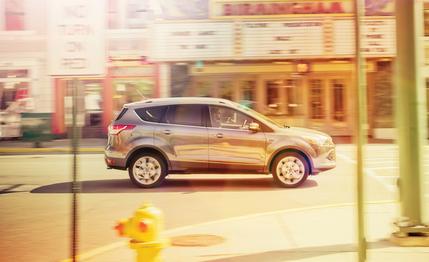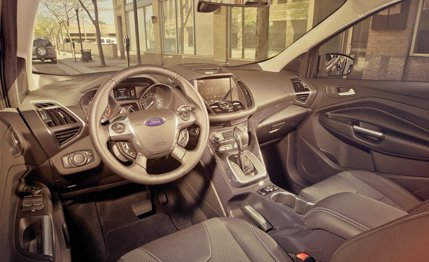
 Instrumented Test
Instrumented Test


Ask typical owners why they drive SUVs, and you’ll hear, “I have a dog. Also, I like a high seating position in traffic,” or words to that effect. Now that first-person shooter games are all anyone needs to stroke his or her spirit of adventure, SUVs still thrive because there are dozens to choose from and because they beat every car’s carrying capacity. When you’re hauling Fido to the vet, taking the kids camping, or schlepping fuel for your LeMons racer, an SUV— even a small crossover—makes sense.
Ford figured out the SUV better than most, first with the mid-size Explorer, later with the compact Escape. Since Dearborn’s boxy baby rolled forth in 2000, more than 2 million have been sold, with only modest design and engineering updates. Last year, when the original platform was on its last legs, the Escape was still America’s most popular SUV, with more than a quarter-mil- lion sales. Thanks, incentives.
Through March of this year, Honda’s CR-V is top dog, at least until the 2013 Escape builds momentum. From the plant that builds it to the fresh interior and exterior, everything about Ford’s compact crossover is new. In place of the platform co-developed with Mazda, this Escape shares Focus underpinnings and a basic design sold as the Kuga in china, Europe, and other markets. The manual transmission, V-6 engine, and hybrid powertrain are all purged from the program. (The coming Ford c-Max, a close cousin to the Escape, will be all-hybrid.) Two new EcoBoost inline-fours bolster the Escape’s base carry-over 2.5-liter: the turbocharged 1.6-liter produces 178 horsepower, and the blown 2.0-liter is rated at a strapping 240. A six-speed automatic is now standard with all three engines whether you opt for front- or four-wheel drive.
Inevitably, the new Escape is larger, heavier, and more expensive than the outgoing model. The base price for a front-drive Escape s (the cheapest edition) is $23,295. Lacking full leather, a trailer hitch, and a sunroof, the Escape titanium 4WD tested here lists at $34,735; adding those options would hike the sticker above $37,000. We don’t see Escapes competing with $37,000– $40,000 Audi Q5s, BMW X3s, Cadillac SRXs, and Land Rover LR2s. But Ford has made good use of the extra inches, pounds, and dollars to bless this generation with improved performance, better mileage, and clever features, including a few goodies no Cadillac offers.


The Escape’s new duds are stylish and contemporary. The sweptback windshield blends smartly into the airfoil-shaped roof. A tasteful assortment of ribs and creases adds character to the nose and flanks. Headlamps defining the front corners, blacked- out bumpers, and diagonal spars that start low and run over the hood and up the wind- shield pillars make the best of the Escape’s tall, narrow proportions.
Swing open the Escape’s thick, heavy door, and you can slip into the squishy driver’s seat without climbing up or dropping down. the front buckets—ours were trimmed in a mix of leather and fabric—provide excellent omnidirectional support. Unfortunately, some of the visibility advantage provided by a high seating position is squandered by the thick A- and D-pillars, the huge radii at the bottom corners of the windshield, and the squinty liftgate window.
There’s a touch more elbowroom than before, even with the major structural and energy-absorbing upgrades aimed at improved collision protection. Instead of bolstering the door-panel trim with crushable plastic, Ford uses more eco-friendly kenaf plant fibers. The major space gains are in the back seat: Hip room is up by 3.3 inches, legroom is 1.2 inches greater, and there’s ample clearance beneath the front buckets to plant size-13 wingtips.